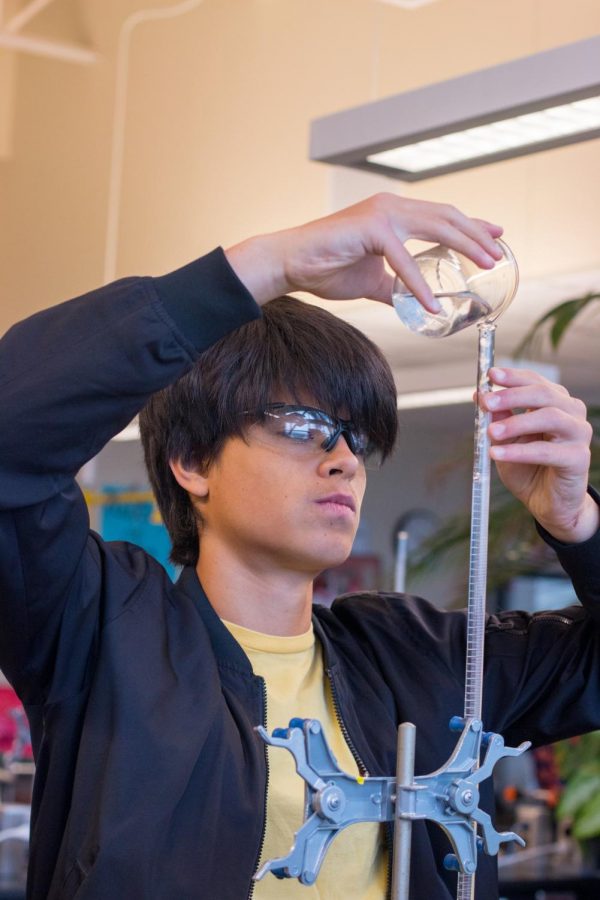CON
The benefits that would come with a complete switch to the metric system may not outweigh the challenges that the change would present
Junior Emilio Rosas-Linhard pours a solution into a graduated cylinder during a chemistry class. Even though the official measurement system is imperial, American scientists almost exclusively teach and use the metric system.
March 14, 2019
When growing up in America, students learn to have a complicated relationship with measurement systems. We grow up learning that the imperial system is the main way to measure and we see that system being used in sports, at gas stations and in our schools. Despite this, we are also taught the metric system and learn to utilize both in our math and science classes. We learn fractions, decimals, inches, meters, miles, grams and pounds and eventually, almost every student asks the age-old question: why don’t we just use the metric system?
Well, like most things American, it comes down to a long and complicated history of stubbornness and affection for money.
There have been multiple times in history when switching to the metric system would’ve been a much simpler process and it would’ve made sense, but unfortunately, they were all met with failure.
The metric system initially grew in popularity in Europe around the 19th century, with many European countries adopting the system and utilizing it in their colonies. Eventually, it became the global measurement system.
Throughout American history, many notable scholars such as Alexander Graham Bell tried to push for change, but it was never made into law that America should rely solely on the metric system.
One major advancement with conversion to the metric system was with the Metric Conversion Act, which made the metric system the “preferred system of weights and measures for United States trade and commerce.” Despite this, there wasn’t much change in the way we use the imperial and metric system. Factories owners and manufacturers weren’t willing to invest the money to change their equipment and accommodate for a new unit system.
Over time, America has developed a dual measurement system in which many manufacturers print their labels in both imperial and metric, and students nowadays learn the benefits of both systems.
One of the main issues with the idea of a full conversion to the metric system is the logistics behind such a feat. Having to change every speed limit sign alone would be an economic challenge and the many other systems that are based on the imperial system, such as gas stations and car manufacturers, would also have to convert their measurements to one that is unfamiliar to many people. Culturally, a full shift would never become successfully implemented, as people would be reluctant to stop using the measurements they’re used to and it would cause mass confusion to have such a large change.
Manufacturers have shown in the past that it isn’t worth it financially to change, and the imperial system is far too ingrained in our everyday lives to convert fully to the metric system.
Conversions to the metric system for international trades nowadays are simple and are utilized every day in manufacturing when transporting things between countries. Many companies use both systems when printing labels and sizing portions.
At an educational level, students learn to use both systems, which allows them to learn the importance of both fractions and decimals, as well as teaching the usefulness of unit conversion.
Overall, when analyzing whether or not we should make a full switch to the metric system, it is evident that the metric system is already heavily utilized in America and thus the benefits of a full switch wouldn’t outweigh the costs.








Jayda Goodrick • Aug 26, 2024 at 4:29 pm
Well how many states are not involved in the metric system
Paul Blackmon • Apr 26, 2022 at 7:01 pm
The longer we wait, the more far gone we will become as a nation. The globe has shrunk. I DETEST with every cell of my American body being represented to the world as an outlier weirdo. Fortunately, I bucked the status quo and learned the SI and use to the point where I am more comfortable with it than I ever was with the old Caligula “system” my American culture forces me to use. Ignorance is not strength. The world is metric, America. Either deal with it or shrivel and die.
Terry French • Mar 11, 2021 at 7:13 am
I don’t really buy the cultural argument against metric conversion, because I remember going through it as a kid in Canada back in the mid/late 1970s. Canadians were just as accustomed to feet, miles, gallons, etc… as are Americans today, but eventually people got used to metric. I also don’t buy the cost argument, as highway and speed limit signs had to be changed in Canada, the second largest land mass in the world, and that was done too.
Canada only agreed to convert to metric because or government and the US government signed a pact saying that Bush countries would make the transition jointly at the same time. But then, the US government pulled a fat one and back off conversion, because of a backlash from American manufacturers. By that time, it was too late for Canada to fully revert to the imperial system, so we’ve been left in an imprial/metric hybrid limbo ever since.
Roland • Aug 16, 2020 at 8:30 am
It is becoming a disgusting insult when Americans preach to the business world to ‘adapt their products to local markets ‘ yet everywhere they are trying to shove their system down the world’s throat! Not acceptable USA, we will avoid buying anything American and because of it focus on global convention without you. We don’t miss your stuff and know unmistakably what and how much we are getting this way. You can rot alone in your own juice without inconveniencing the whole world. Cannot be more blunt! The rest of the world is just wonderful without you!
Jack • May 14, 2024 at 8:46 am
“We will avoid buying anything American and because of it focus of global convention without you.”
Why are you acting like you have any control over the world’s trade economy?